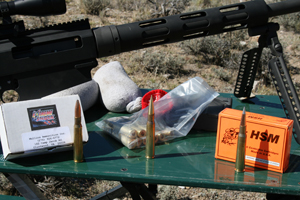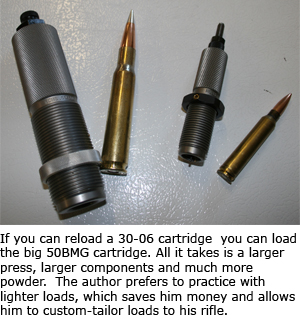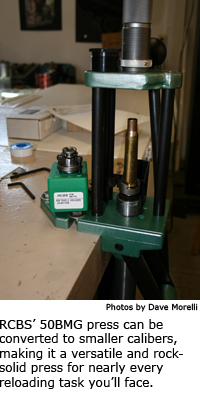
Save time and get more bang for your buck by handloading the big .50 BMG.
 Unlike a musician, whose practice involves only time after the initial investment of an instrument, a tactician must invest in ammo. That can greatly affect how much practice you can afford.
Unlike a musician, whose practice involves only time after the initial investment of an instrument, a tactician must invest in ammo. That can greatly affect how much practice you can afford.
I’ve reloaded ammo since I started shooting. My first rifle was a .308 Winchester, and my first loading outfit was a Lee Loader. Even with the primitive Lee system, I got better results from the rifle at a lower cost than with relatively cheap factory ammo. As I shot more and got into pistols, reloading became an important part of my shooting. It still is, because my hobbies and professional career have centered around shooting.
Loading the Big Gun
Anyone into long-range shooting, whether as a professional sniper or target shooter, will shoot the .50 BMG. In this arena, reloading seems to be necessary to create affordable loads. Further, you can tailor it to the type of shooting you’re doing. A lot of military surplus ammo is available at lower cost, but most rifle makers recommend not using this ammo.
However, current factory ammo can be quite expensive, and it’s not always available everywhere. I’ve also found that like every other cartridge I’ve reloaded, I get better results by developing a load for a specific rifle.
 There really isn’t much difference in loading the .50 than other stuff. It’s a blown-up version of the .30-06. Everything is bigger. Designed from .30-06 specifications, it even duplicates .30-06 velocities — only with a bullet that’s 10 times heavier. Be prepared to have a larger supply of components, especially powder. Charges are quite large, even in reduced loads. The press you’ll need is larger and must be firmly attached to a loading bench to size the big case. Otherwise, the process is similar. Depending on the components you use, reloading will lower your costs and produce a load that will complement the .50’s long-range capabilities.
There really isn’t much difference in loading the .50 than other stuff. It’s a blown-up version of the .30-06. Everything is bigger. Designed from .30-06 specifications, it even duplicates .30-06 velocities — only with a bullet that’s 10 times heavier. Be prepared to have a larger supply of components, especially powder. Charges are quite large, even in reduced loads. The press you’ll need is larger and must be firmly attached to a loading bench to size the big case. Otherwise, the process is similar. Depending on the components you use, reloading will lower your costs and produce a load that will complement the .50’s long-range capabilities.
I started with RCBS, which has a .50 BMG package deal. It comes with a press, dies, a primer, a case trimmer, a huge powder-dump measurer and a bunch of the little do-dads that make the job easier. The press will handle the larger die size. It also comes with a reducer that can screw into the die threads and a 7/8 thread die can be used in the press. All you need for smaller calibers is an adapter that will facilitate various smaller shell-base holders. That makes the press a dual-function unit.
I started by bolting the press to a sturdy table. I then mounted the powder measure next to it but toward the back of the table. After the priming was complete, the powder could be dispensed into the case and put in the press for seating the bullet.
One Large Recipe
I loaded some Barnes’ Banded 750-grain solids, which come 20 to a box. They are pointy-nose bullets designed to cut a clean path through the atmosphere, and they proved to be accurate for the loads I was making.
 I used Hodgdon H50BMG powder, which is made for the big case. Hodgdon also makes US 869, which can be loaded in the .50. Then, I gleaned some loading data from the Hodgdon website.
I used Hodgdon H50BMG powder, which is made for the big case. Hodgdon also makes US 869, which can be loaded in the .50. Then, I gleaned some loading data from the Hodgdon website.
The powder and bullets were easy to find, but I had trouble rounding up primers. The BMG takes a CCI 35 primer, and most places sell them in lots of 500. Most outlets I checked were out of stock, but I got some from a friend who owns a gun shop in Post Falls, Idaho, called Going Ballistic. The brass came from rounds I'd previously shot from The Hunting Shack and Extreme Shock. Both outfits assemble great ammo, and I found it to be accurate. The Hunting Shack’s A-Max bullet disintegrated on contact with the backstop, as did Extreme Shock’s soft tip.
The loads on the Hodgdon Web site had the 750-grain bullet splitting the air at 2,800 to 2,900 feet per second. According to the Hodgdon info, 250 grains of US 869 will push the 750-grain bullet around 2,944 fps, and 233 grains of H50BMG will get the same bullet out at 2,800 fps. With those big loads, I don’t think 1/10 of a grain would be noticeable, but increments of .5 grains of even full grains would be small enough.
Believing those were maximum loads, I started a little lighter. Really, I was looking for an accurate load that was a little lighter to shoot. I was using the Bushmaster BA-50 with the loads. Like all quality .50s, it isn’t really unpleasant to shoot, but I wanted to use less powder and get good results. That would lower the cost of reloading, which, as mentioned, is kind of the point of reloading. At 250 grains a pop, it doesn’t take long to go through a pound of powder.
The loading sequence is really not much different than with other rounds. I started by making sure the case length was acceptable. Long cases got a turn in the length sizer that came with the RCBS 50 BMG kit. The priming attachment goes into place easily, and the primer is pressed in after full-length sizing in the RCBS dies. With a bit of lubrication, the big press made the job effortless. I was amazed at how easily the case slipped through the die, as I’ve had regular rifle rounds give me trouble.
I used the RCBS powder dump to charge the cases, and after checking a few loads with RCBS’ Charge Master 1500, I got almost perfect consistency. I could have used the 1500 to dole out the load, but the dump was faster with the big charges, and I didn’t notice decreased accuracy at the range. The Barnes Banded Solid was seated to an overall length of 5.45 inches to top off the cartridge.
The reloads performed great out of the Bushmaster BA-50. I shot them next to The Hunting Shack ammo and Extreme Shock from Mullins Ammunition. The reloads were plenty accurate and mild enough for practice. The Barnes Solids did not disintegrate on the backstop like the factory ammo, but it flew well. I placed the horse pill on an 18-inch rock at 1,400 yards.
Dual Purpose
The .50 BMG is an awesome rifle capable of accuracy at unbelievable ranges, but it’s like any other tool: The operator is the biggest part of that capability. Even though the rifle is capable of long-range accuracy, you must practice with the tool to reach its potential.
Reloading will help you tune the cartridge to the rifle — and give you a break in the wallet to allow for more time on the range.

Next Step: Get your FREE Printable Target Pack
Enhance your shooting precision with our 62 MOA Targets, perfect for rifles and handguns. Crafted in collaboration with Storm Tactical for accuracy and versatility.
Subscribe to the Gun Digest email newsletter and get your downloadable target pack sent straight to your inbox. Stay updated with the latest firearms info in the industry.

![Best Concealed Carry Guns In 2025 [Field Tested] Wilson Combat EDC X9S 1](https://gundigest.com/wp-content/uploads/Wilson-Combat-EDC-X9S-1-324x160.jpg)


![Best 9mm Carbine: Affordable PCCs [Tested] Ruger Carbine Shooting](https://gundigest.com/wp-content/uploads/Ruger-Carbine-Shooting-100x70.jpg)
![Best AR-15: Top Options Available Today [Field Tested] Harrington and Richardson PSA XM177E2 feature](https://gundigest.com/wp-content/uploads/Harrington-and-Richardson-PSA-XM177E2-feature-100x70.jpg)

[…] Handloading The .50 BMG […]
[…] Handloading The .50 BMG […]